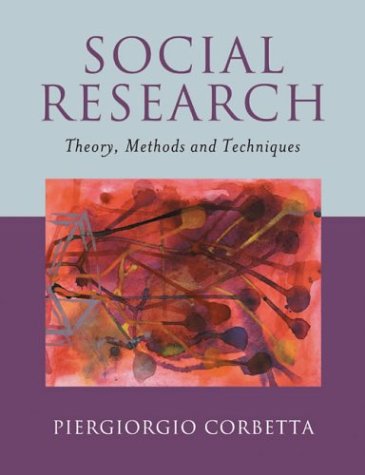Social Research: Theory, Methods and Techniques
Corbetta, Piergiorgio
Vanderbilt University Press, Nashville
2003
336 + vii pages
0761972536 (pb)
0761972528 (hb)
Order this book?
 The market for research methods books must be healthy as Sage's 2005 Research Methods catalogue alone lists nearly fifty pages of textbooks. Social Research: Theory, Methods and Techniques is slightly different as it is a translation from Italian (by Bernard Partrick) and not originally written in English. It consists of 11 chapters, divided into three sections: (1) The logic of social research; (2) Quantitative techniques; and (3) Qualitative techniques. The first two chapters in Section I focus on the paradigms of social research and, more specifically, the differences between qualitative and quantitative research offering a fairly extensive discussion of epistemology. The remaining nine chapters cover the range of qualitative (Section II) and quantitative (section III) methods. Each chapter has a useful summary as well as list of further reading.
The market for research methods books must be healthy as Sage's 2005 Research Methods catalogue alone lists nearly fifty pages of textbooks. Social Research: Theory, Methods and Techniques is slightly different as it is a translation from Italian (by Bernard Partrick) and not originally written in English. It consists of 11 chapters, divided into three sections: (1) The logic of social research; (2) Quantitative techniques; and (3) Qualitative techniques. The first two chapters in Section I focus on the paradigms of social research and, more specifically, the differences between qualitative and quantitative research offering a fairly extensive discussion of epistemology. The remaining nine chapters cover the range of qualitative (Section II) and quantitative (section III) methods. Each chapter has a useful summary as well as list of further reading.
Corbetta makes good use of examples― often classic studies ― to provide more background information than one would find in similar social science textbooks. For example, Donald Roy's work is mentioned, the short introduction (pages 240-41) places this participant observation research in its context, highlights the kind of phenomena in which Roy was interested, and details the research process spent 'in a small workshop that produced components for railway carriages.' Using so many classical studies as examples makes for a better-referenced methods book. Corbetta also provides a brief history of a method, which makes reading a methods book that little bit more interesting. For example, the concept of representativeness in quantitative surveys was 'theoretically systematized in the middle of the 1930s in the writings of the Polish statistician Jerzy Neyman..' (page 120).
My hobbyhorse is pilot studies in social research. The term 'pilot study' is not indexed, but 'pre-testing' is. However, pre-testing in this book refers to both (1) before-and-after studies, where the 'two measurements of the dependent variable are also called pre-test and post-test' (page 105); and (2) 'the test phase …what is commonly called pre-testing' (page 149). The section on pilot studies covers exploratory studies as well as the piloting of a particular instruments. Corbetta covers both quantitative (e.g. pre-testing the penultimate version of the questionnaire) and qualitative research piloting (e.g. trial interviews to train interviewers).
As this book covers the whole range of research methods, individual techniques are not always given much space, thus 'focus groups' (pages 276-77) and 'mixed methods' (pages 282-83) cover less than two pages each. Corbetta is not keen on 'mixed methods':
..I believe that the same researcher is unlikely to be able to conduct studies by means of the two different approaches (obviously at different times) and achieve equally good results. His (sic) training as a scholar, indeed the very structure of his scientific mind-set, will probably prelude this kind of flexibility (page 51).
Corbetta's view is that quantitative and qualitative methods are not 'simply two different technical manifestations of what is substantially the same vision of the social world and of the purpose of research', they are the 'direct and logically consequential expression of two different epistemological visions, the methodological manifestation of two different paradigms which imply alternative conceptions of social reality, research objectives, the role of the researcher and technological instruments' (page 50).
Corbetta has the annoying habit of using 'etc.', which gives a sense of imprecision. So when discussing the interviewer's initial contact with the interviewee (page 150) the advice is to consider the interviewer's approach 'in terms of appearance (dress, etc.)…' On response bias in questionnaires we read that 'Those who comply are likely to be more motivated, better educate, perhaps younger, etc.' (page 146). Whilst the research of the Chicago School 'mostly involved social marginalization resulting from immigration and urbanization: vagabonds, gangs, prostitutes, black ghettos, slums, immigrant communities, etc.' (page 240). On response bias: '.. a response may be influenced by the way in which the question is expressed, by its position in the questionnaire, by the interviewer's approach, etc.' (page 126).
Corbetta makes some detailed recommendations, which appear experience-based rather than evidence-based, e.g. 'a normal survey involves at least 1,000 interviews … (page 128). Whilst focus groups are 'generally made up of about ten people..' (page 276). My last comment is that the index, always very important in a textbook, is not complete, for example, 'mixed methods', 'gate-keepers' or 'ethics' are not indexed.
Overall, this is a useful textbook for teaching methodology and methods to undergraduates in the latter years, and postgraduate students. For students conducting postgraduate research project there is not enough detail on their particular chosen method.
Edwin van Teijlingen
University of Aberdeen |

